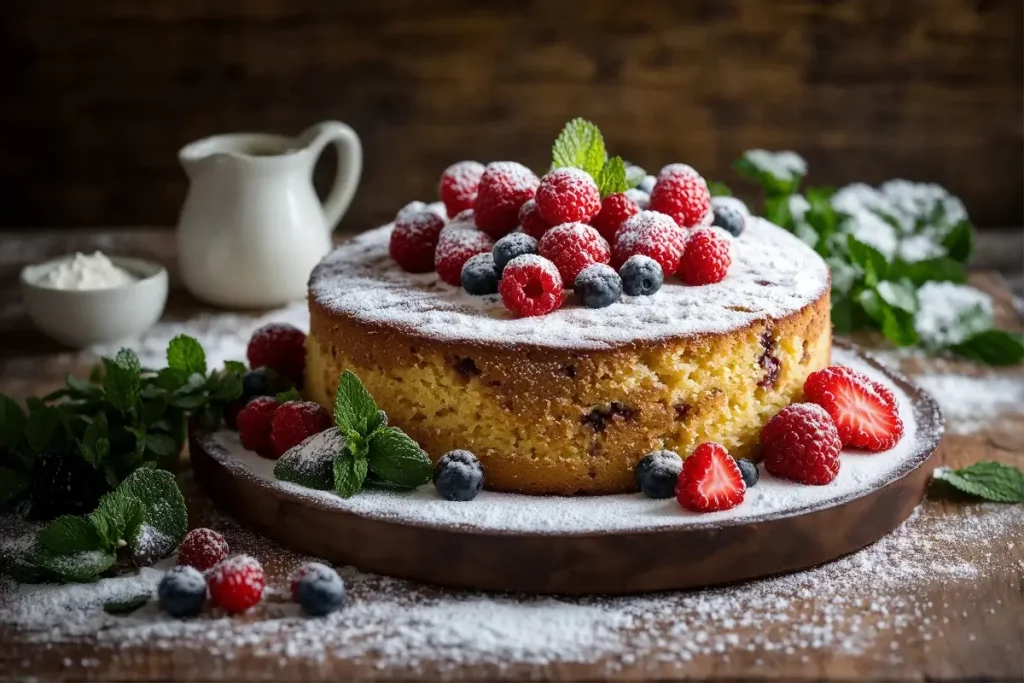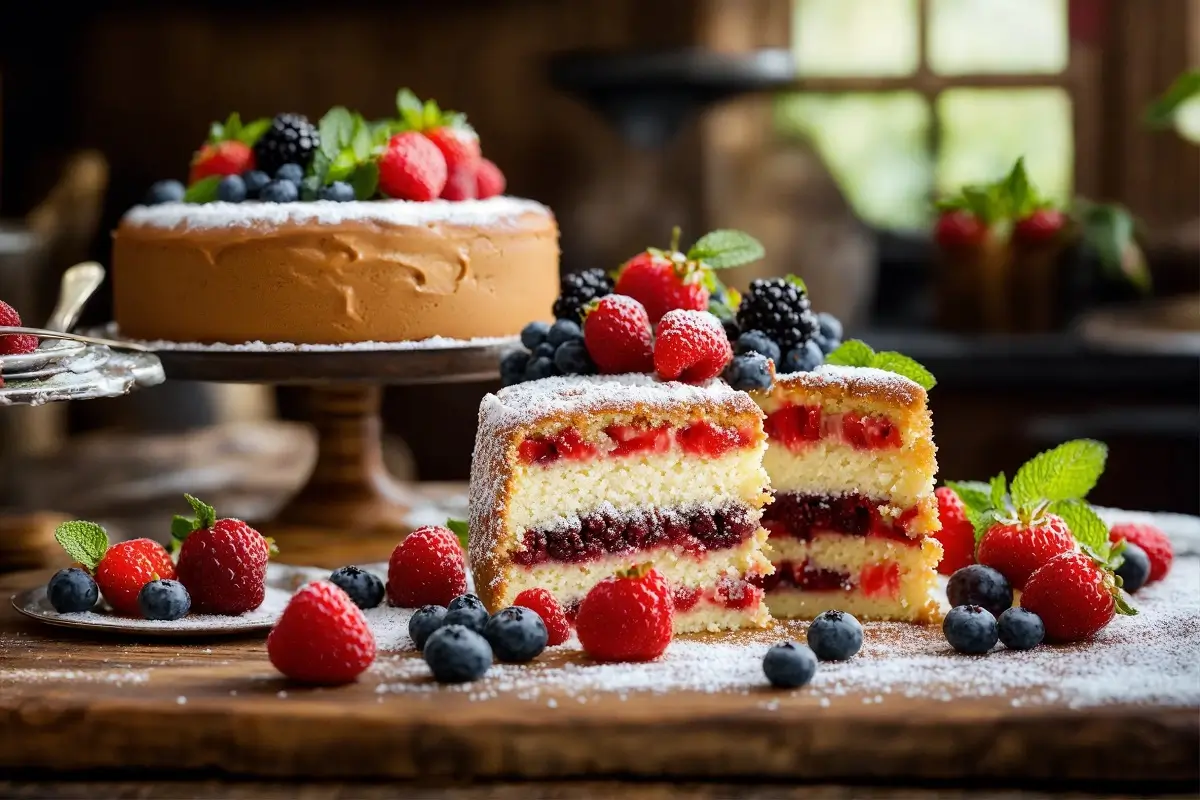Introduction to Fricasse Cake
Origins and Popularity
Fricasse cake, a delightful culinary gem, has its roots deeply embedded in the rich soils of North African culture, particularly in Tunisia. This sweet and savory masterpiece, known locally as “fricassé,” is a testament to the region’s diverse and vibrant culinary heritage. Interestingly, despite its cake-like name, fricasse is a unique blend of flavors and textures, making it a standout dish in the world of pastries.
Originally, fricasse cake was a simple, yet ingenious creation by resourceful cooks who mastered the art of combining readily available ingredients to produce something extraordinary. Over time, it has traveled across borders, evolving with each culture it touched, yet retaining its core essence. Today, fricasse cake is celebrated not just in its homeland but around the globe, enchanting palates with its distinctive taste and texture.
Key Ingredients
The secret to the fricasse cake’s irresistible allure lies in its ingredients. At its heart is a yeast-based dough, which is a crucial element that imparts a light and airy texture to the cake. This dough is then deep-fried to golden perfection, creating a delightful contrast between its crispy exterior and soft, fluffy interior.
But the magic doesn’t end there. Post-frying, the cake is often bathed in a sweet syrup or glaze, adding a layer of moisture and enhancing its sweetness. This step is not just about flavor; it’s a crucial process that ensures the cake’s texture remains moist and tender.
In some variations, the fricasse cake is filled with a range of ingredients, from sweet apricots and dates to savory meats and vegetables, showcasing its versatility and adaptability to different tastes and preferences. This ability to transform while maintaining its unique character is what makes fricasse cake a beloved dish in many households.
In conclusion, fricasse cake is more than just a dessert; it’s a culinary journey that speaks volumes about its rich heritage and the creativity of those who make it. Its popularity continues to grow, inviting everyone to explore and enjoy this delightful treat.
The Art of Baking Fricasse Cake
Step-by-Step Baking Guide
Baking a fricasse cake is akin to orchestrating a symphony; each step contributes to creating a harmonious and delightful outcome. Let’s embark on this culinary adventure:
- Preparing the Yeast Dough: Start by mixing high-quality yeast with flour, water, and a pinch of sugar. This mixture should be kneaded until smooth and left to rise, allowing the yeast to work its magic and give the dough its characteristic lightness.
- Shaping and Frying: Once risen, divide the dough into small portions and shape them as desired. Heat premium-quality oil in a deep fryer or a deep pan. Carefully place the dough pieces into the hot oil, frying them until they turn a beautiful golden brown. Remember, the key here is not to overcrowd the pan, ensuring each piece cooks evenly.
- Syrup or Glaze Infusion: After frying, while the cakes are still warm, immerse them in a sweet syrup or glaze. This step is crucial for adding moisture and sweetness, enhancing the overall flavor profile of the cake.
- Filling (Optional): For those who prefer a filling, this is the moment to get creative. You can opt for sweet fillings like fruit jams or savory ones like spiced meats or vegetables.
- Final Touches: Allow the cakes to soak in the syrup or glaze for a while, then serve them fresh and warm, garnished with a sprinkle of powdered sugar or a drizzle of honey for an extra touch of sweetness.
Tips for Perfect Texture
- Quality of Ingredients: The choice of ingredients plays a pivotal role. Fresh, high-quality yeast and flour can significantly impact the texture of the cake.
- Temperature Control: Maintaining the right oil temperature is crucial. Too hot, and the cakes will burn on the outside while remaining uncooked inside; too cool, and they’ll absorb too much oil, becoming greasy.
- Timing is Everything: Keep a watchful eye on the frying process. Fricasse cakes cook quickly, and even a few extra seconds can mean the difference between perfect and overdone.
- Soaking Time: Don’t rush the soaking step. Allowing the cakes to rest in the syrup or glaze ensures they absorb the flavors fully, resulting in a moist and delectable texture.
Variations of Fricasse Cake
Regional Twists on the Classic Recipe
Fricasse cake, much like a chameleon, adapts beautifully to the tastes and ingredients of various regions, creating a tapestry of flavors. Here are some of the most intriguing regional variations:
- The Mediterranean Touch: In some Mediterranean countries, fricasse cakes are infused with local flavors like olive oil, citrus zest, and honey, offering a delightful fusion of sweet and tangy notes.
- The Middle Eastern Version: Here, the cakes often feature rich fillings like dates, nuts, and spices such as cinnamon and cardamom, reflecting the region’s love for deep, aromatic flavors.
- The European Influence: European variations might include lighter, airier textures with subtle flavors like vanilla or almond extract, catering to a palate that favors understated sweetness.
- The North American Twist: In North America, fricasse cakes have been adapted to include ingredients like maple syrup, berries, and even chocolate chips, making them a hit in contemporary dessert menus.
Innovative Modern Variations
Innovation in the kitchen has led to some exciting modern takes on the classic fricasse cake:
- Vegan and Gluten-Free Options: With the rise of dietary preferences and restrictions, chefs have created vegan and gluten-free versions of fricasse cakes, using alternative flours and plant-based ingredients.
- Savory Surprises: Some modern recipes have turned the fricasse cake into a savory snack, incorporating ingredients like cheese, herbs, and even minced meat, perfect for an appetizer or a hearty snack.
- Miniature Delights: Bite-sized fricasse cakes are becoming increasingly popular, especially in party settings. These mini versions are not only cute but also allow guests to enjoy a variety of flavors in one sitting.
- Fusion Flavors: Chefs are experimenting with cross-cultural fusion, combining fricasse cake with elements from other cuisines, like using matcha, dulce de leche, or even incorporating savory Asian spices.
Nutritional Profile of Fricasse Cake
Health Benefits and Considerations
Fricasse cake, while primarily known for its delightful taste, also brings with it a set of nutritional aspects that are worth considering. Here’s a closer look:
- Energy Content: Given its primary ingredients like flour and sugar, fricasse cake is a high-energy food. It’s an excellent source of carbohydrates, providing a quick energy boost.
- Protein and Fats: Depending on the fillings and ingredients used, fricasse cake can also contribute a fair amount of protein, especially in variations that include nuts, dairy, or meat. The frying process, however, does add to the fat content, which is something to be mindful of.
- Vitamins and Minerals: If fruits, nuts, or certain vegetables are included in the recipe, they can add vitamins and minerals to the cake. For instance, dates or apricots can provide potassium and dietary fiber.
- Dietary Considerations: It’s important to note that traditional fricasse cake, due to its ingredients and cooking method, may not be suitable for everyone. Those with dietary restrictions or health concerns related to sugar, gluten, or fried foods should consume it in moderation.
Calorie Count and Dietary Information
- Caloric Density: Fricasse cake is calorically dense, primarily due to the frying process and sweet fillings. A single serving can range significantly in calorie count based on size and ingredients.
- Balancing the Diet: If you’re including fricasse cake in your diet, it’s advisable to balance it with lower-calorie, nutrient-rich foods throughout the day. This ensures a well-rounded and healthy diet.
- Customizing for Health: For those looking to enjoy fricasse cake with fewer calories or specific dietary needs, there are options. Using alternative sweeteners, baking instead of frying, or opting for gluten-free flour are ways to make this treat more diet-friendly.
Pairing Fricasse Cake with Beverages
Best Drinks to Complement the Cake
Ah, the delightful Fricasse Cake! It’s not just a treat for your taste buds but a journey for your senses. Now, let’s dive into the perfect companions for this culinary delight: beverages. Pairing the right drink with Fricasse Cake can elevate your dining experience to a whole new level.
Firstly, consider the texture and flavor of the cake. Is it rich and creamy? Or light and zesty? For a richer cake, a glass of sparkling wine does wonders. It’s like a symphony where the bubbles dance with the creaminess of the cake. On the other hand, for a lighter version, how about a cup of Earl Grey tea? The bergamot’s citrusy notes create a harmonious blend with the cake’s delicate flavors.
Non-Alcoholic Pairings
But hey, not everyone’s on board with alcohol, and that’s totally fine! For a non-alcoholic twist, let’s think outside the box. A chilled fruit punch, perhaps? The fruitiness complements the cake’s sweetness, creating a refreshing balance. Or, for a cozier option, a hot chocolate with a dash of cinnamon can be a heartwarming companion to your Fricasse Cake. It’s like a hug in a mug!
Pairing with Flavors
To enhance your fricasse cake experience, consider pairing it with Air Fryer Salmon Bites for a balance of sweet and savory. The crispy, healthy salmon bites offer a delightful contrast to the sweet fricasse cake.
A Journey of Flavors
Each bite of the fricasse cake takes you on a flavorful journey. Its soft, moist texture combined with a subtle sweetness makes it a perfect dessert for any occasion. For those who enjoy experimenting with different cuisines, try incorporating elements from the Delicious Pan-Seared Salmon Bites Recipe to add a unique twist to your meal.
Fricasse Cake in Different Cultures
Global Influence and Adaptations
Fricasse Cake isn’t just a dessert; it’s a cultural mosaic. Across the globe, this cake has been embraced and adapted in myriad ways. In France, they might add a touch of lavender, infusing the cake with a Provençal essence. Meanwhile, in Japan, matcha could be the star ingredient, giving the cake a distinct, earthy flavor. Each adaptation tells a story, a tale of local tastes meeting a classic recipe.
Cultural Significance
But it’s not just about taste; it’s about tradition and significance. In some cultures, Fricasse Cake is more than a dessert; it’s a part of celebrations, a symbol of hospitality. In Italy, for instance, it might be served during family gatherings, embodying the warmth of togetherness. Understanding these cultural nuances adds depth to our appreciation of this versatile cake.
Decorating and Presenting Fricasse Cake
Creative Decoration Ideas
Now, let’s talk about dressing up your Fricasse Cake. Decorating this cake is an art form, a chance to express your creativity. Think edible flowers for a touch of elegance, or a sprinkle of gold dust for a bit of luxury. The key is to complement the cake’s flavor and texture, not overpower it. A drizzle of caramel, perhaps, for a sweet finish?
Presentation Techniques for Special Occasions
And when it comes to special occasions, presentation is everything. Imagine a Fricasse Cake as the centerpiece at a wedding, adorned with roses matching the bridal theme. Or for a birthday, personalized with a message written in icing. The way you present this cake can turn it from a mere dessert into a memorable experience.
Storing and Preserving Fricasse Cake
Best Practices for Freshness
Let’s face it, no one likes a stale cake. To keep your Fricasse Cake fresh as a daisy, proper storage is key. If you’re planning to devour it within a couple of days, keeping it in an airtight container at room temperature works wonders. This method helps in maintaining its moisture and flavor.
Long-Term Storage Solutions
But what if you need to store it for longer? Fear not, for the freezer is your friend! Wrap the cake in cling film, then foil, and tuck it away in the freezer. This method can keep your cake fresh for up to three months. Just remember to thaw it slowly in the fridge before serving, to preserve its texture and taste.
Fricasse Cake for Dietary Restrictions
Gluten-Free and Vegan Options
In today’s world, dietary restrictions are no longer a barrier to enjoying delicious desserts. For those avoiding gluten, a range of alternative flours like almond or coconut can be used. And for the vegans out there, substitutes like flaxseed eggs and plant-based creams can work magic, ensuring everyone gets a slice of the joy.
Low-Sugar and Allergen-Free Variants
And let’s not forget about those watching their sugar intake or dealing with allergies. Sweeteners like stevia or erythritol can replace sugar, and allergen-free ingredients can be used to cater to specific dietary needs. With these adaptations, Fricasse Cake becomes a treat that’s inclusive for all.
Hosting a Fricasse Cake Party
Planning and Hosting Tips
Thinking of throwing a Fricasse Cake party? Well, you’re in for a treat! Planning is key here. Decide on your theme, be it a classic tea party or a modern dessert soiree. Prepare your cakes in advance, and don’t forget to consider your guests’ dietary preferences. A variety of flavors and options ensures everyone has something to relish.
Themed Decoration Ideas
And for decorations, let your imagination run wild. Match your table setting to the theme of your party. Use flowers, candles, or even themed tableware to create an ambiance that complements your delicious Fricasse Cakes. Remember, the devil is in the details!
Fricasse Cake and Special Occasions
Wedding and Birthday Cake Alternatives
Fricasse Cake isn’t just for afternoon tea; it’s also a fantastic alternative for traditional wedding or birthday cakes. Its versatility allows for customization to fit any theme or preference. Imagine a tiered Fricasse Cake at a wedding, each layer a different flavor. Or a fun, colorful version for a child’s birthday party. It’s all about making those special moments even sweeter.
Seasonal Variations
And let’s not forget seasonal variations. A pumpkin-spiced Fricasse Cake for autumn, or a berry-laden one for summer. These seasonal twists not only add a unique flavor but also bring a piece of the season into your celebration.
Fricasse Cake in Professional Baking
Incorporating into Restaurant Menus
Fricasse Cake is not just a home baker’s delight; it’s also making waves in the professional baking world. Chefs are incorporating it into their menus, offering gourmet versions that tantalize the taste buds. From fine dining restaurants to quaint cafes, this cake is finding its way into the hearts of patrons.

FAQs about Fricassee Cake
Q: What does fricassee mean in cooking?
A: Fricassee is a traditional cooking method often associated with French cuisine. It refers to a technique of cooking where meat, typically chicken, is first sautéed in butter and then braised in a sauce made from its own juices and additional ingredients like broth, herbs, and vegetables. This method results in tender, flavorful meat with a rich, creamy sauce.
Q: What is the difference between stew and fricassee?
A: While both stew and fricassee involve cooking meat in liquid, there are key differences. Stew typically involves cooking the meat fully submerged in a liquid, often with larger chunks of vegetables and a longer cooking time. Fricassee, on the other hand, starts with sautéing the meat, followed by a shorter braising in a sauce that is thickened and more refined. The result is a dish that’s lighter and with a more delicate flavor profile compared to the hearty nature of a stew.
Q: What is chicken fricassee made of?
A: Chicken fricassee is made using cut-up chicken pieces, which are first lightly browned in butter. The chicken is then simmered in a sauce typically made from chicken broth, herbs, and sometimes cream or a roux for thickening. Common additions include mushrooms, onions, and carrots. The dish is known for its creamy texture and rich, comforting flavors.
Conclusion
Fricassee cake, while borrowing its name from the classic cooking technique, offers a unique twist on traditional fricassee dishes. This culinary creation combines the comforting, rich flavors of a fricassee with the delightful presentation and texture of a cake. It’s a testament to the versatility and evolving nature of culinary arts, blending classic techniques with modern creativity to produce something truly unique and enjoyable. Whether you’re a fan of traditional fricassee or looking for a new culinary adventure, fricassee cake is a dish that promises to deliver a delightful and memorable experience.

